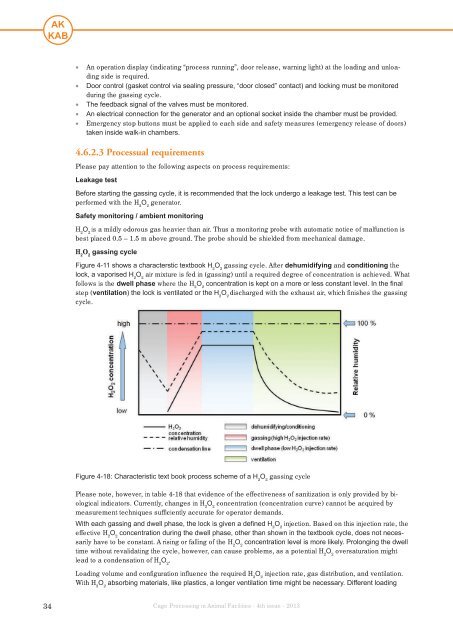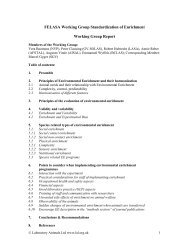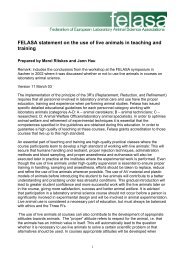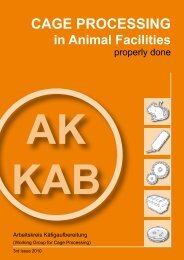• An operation display (<strong>in</strong>dicat<strong>in</strong>g “process runn<strong>in</strong>g”, door release, warn<strong>in</strong>g light) at the load<strong>in</strong>g and unload<strong>in</strong>gside is required.• Door control (gasket control via seal<strong>in</strong>g pressure, “door closed” contact) and lock<strong>in</strong>g must be monitoreddur<strong>in</strong>g the gass<strong>in</strong>g cycle.• The feedback signal of the valves must be monitored.• An electrical connection for the generator and an optional socket <strong>in</strong>side the chamber must be provided.• Emergency stop buttons must be applied to each side and safety measures (emergency release of doors)taken <strong>in</strong>side walk-<strong>in</strong> chambers.4.6.2.3 Processual requirementsPlease pay attention to the follow<strong>in</strong>g aspects on process requirements:Leakage testBefore start<strong>in</strong>g the gass<strong>in</strong>g cycle, it is recommended that the lock undergo a leakage test. This test can beperformed with the H 2O 2generator.Safety monitor<strong>in</strong>g / ambient monitor<strong>in</strong>gH 2O 2is a mildly odorous gas heavier than air. Thus a monitor<strong>in</strong>g probe with automatic notice of malfunction isbest placed 0.5 – 1.5 m above ground. The probe should be shielded from mechanical damage.H 2O 2gass<strong>in</strong>g cycleFigure 4-11 shows a characterstic textbook H 2O 2gass<strong>in</strong>g cycle. After dehumidify<strong>in</strong>g and condition<strong>in</strong>g thelock, a vaporised H 2O 2air mixture is fed <strong>in</strong> (gass<strong>in</strong>g) until a required degree of concentration is achieved. Whatfollows is the dwell phase where the H 2O 2concentration is kept on a more or less constant level. In the f<strong>in</strong>alstep (ventilation) the lock is ventilated or the H 2O 2discharged with the exhaust air, which f<strong>in</strong>ishes the gass<strong>in</strong>gcycle.Figure 4-18: Characteristic text book process scheme of a H 2O 2gass<strong>in</strong>g cyclePlease note, however, <strong>in</strong> table 4-18 that evidence of the effectiveness of sanitization is only provided by biological<strong>in</strong>dicators. Currently, changes <strong>in</strong> H 2O 2concentration (concentration curve) cannot be acquired bymeasurement techniques sufficiently accurate for operator demands.With each gass<strong>in</strong>g and dwell phase, the lock is given a def<strong>in</strong>ed H 2O 2<strong>in</strong>jection. Based on this <strong>in</strong>jection rate, theeffective H 2O 2concentration dur<strong>in</strong>g the dwell phase, other than shown <strong>in</strong> the textbook cycle, does not necessarilyhave to be constant. A ris<strong>in</strong>g or fall<strong>in</strong>g of the H 2O 2concentration level is more likely. Prolong<strong>in</strong>g the dwelltime without revalidat<strong>in</strong>g the cycle, however, can cause problems, as a potential H 2O 2oversaturation mightlead to a condensation of H 2O 2.Load<strong>in</strong>g volume and configuration <strong>in</strong>fluence the required H 2O 2<strong>in</strong>jection rate, gas distribution, and ventilation.With H 2O 2absorb<strong>in</strong>g materials, like plastics, a longer ventilation time might be necessary. Different load<strong>in</strong>g34Cage Process<strong>in</strong>g <strong>in</strong> <strong>Animal</strong> <strong>Facilities</strong> · 4th issue · 2013
configurations can thus require <strong>in</strong>dividual program cycles. The effectiveness of them should always be verifiedand each process should ideally be validated. When plann<strong>in</strong>g the mach<strong>in</strong>es, this needs to be taken <strong>in</strong>to account.Cycle developmentThe process parameters of a cycle are adjusted to each lock and its load. The cycle development must be discussedwith the manufacturer of the generator. In order to avoid material damage, clearly visible condensationmust be averted. Please f<strong>in</strong>d below <strong>in</strong>formation on applications (e.g. electronic devices) and cycle-relevantparameters:• Humidity exceed<strong>in</strong>g the saturation level must be avoided (verifiable with mirror / pane test). Room capacity,<strong>in</strong>itial temperature and humidity must be considered.• The H 2O 2<strong>in</strong>jection rate must be adjusted to the absorption rate of the chamber surface and load.• Surface temperature and volume of the items to be gassed <strong>in</strong>fluence the maximum allowable, condensation-freeH 2O 2concentration (too cold surfaces bear a higher condensation risk).• The warm H 2O 2air mixture should be streamed <strong>in</strong>to free space (e.g. from above) <strong>in</strong> order to avoid directcontact with cold surfaces (e. g. walls and doors) result<strong>in</strong>g <strong>in</strong> condensation.• Computers and other electronic devices should be cleaned <strong>in</strong> advance (dust should be removed) and stayswitched on while be<strong>in</strong>g gassed (PC ventilators, fan units, etc. must be on).• Heavy condensation leads to <strong>in</strong>creased H 2O 2consumption, differences <strong>in</strong> concentration distribution, <strong>in</strong>creasedrisk of material damage, and a longer ventilation time.• Pre-heat<strong>in</strong>g long supply pipes can help avoid heavy condensation.Proof of efficacy / validationThe distribution of H 2O 2concentration is tested with a colour change of chemical <strong>in</strong>dicators. A visual verificationthrough an <strong>in</strong>spection w<strong>in</strong>dow can be made while the process is runn<strong>in</strong>g.The microbiological efficacy is verified by use of biological <strong>in</strong>dicators, usually H 2O 2gass<strong>in</strong>g-suited spore strips(Geobacillus stearothermophilus) hold<strong>in</strong>g a population of 10 5 to 10 6 . When agreed upon with the operator,other organisms (e.g. Bacillus subtilis, Enterococcus faecium) can be used for verification, too. At least six ofthese biological <strong>in</strong>dicators per m³ spatial volume must be placed at crucial po<strong>in</strong>ts <strong>in</strong>side the lock.4.6.2.4 Processual documentationThe H 2O 2generator should automatically compile a cycle record. Accord<strong>in</strong>g to GLP, document<strong>in</strong>g is necessaryfor assign<strong>in</strong>g a given item <strong>in</strong> the process<strong>in</strong>g procedure to a recorded cycle. The cycle record should conta<strong>in</strong><strong>in</strong>formation on temperature, relative humidity, air flow, operator, date, time, <strong>in</strong>jection time and rate, ventilationtime, total consumption of H 2O 2per cycle phase, time sequence, selected gass<strong>in</strong>g program, notices of malfunction,and release.4.6.3 Requirements of process<strong>in</strong>g procedures by means of peracetic acidProcedures us<strong>in</strong>g peracetic acid (PAA) have become less important and are often replaced by H 2O 2procedures.Below you will f<strong>in</strong>d essential <strong>in</strong>formation on the effectiveness and suitability as well as limitation of PAAfor sanitization <strong>in</strong> locks.Sanitization with peracetic acidSanitization with PAA is a wet procedure that is only suited for items with a non porous surface. PAA is a highlyeffective dis<strong>in</strong>fectant with highly oxidis<strong>in</strong>g characteristics. For a safe handl<strong>in</strong>g of PAA, please consult therespective work safety data sheets (please pay attention to the safety data sheets of the manufacturer). A lowconcentration of PAA (0.5 – 1.5 %) <strong>in</strong>activates spores, bacteria, viruses, and fungi at a low temperature of 4 to20 °C.PAA <strong>in</strong> diluted solution consists of a balance of H 2O 2and acetic acid. Therefore, the limit levels of H 2O 2(1 ppm)and acetic acid (10 ppm) are of crucial <strong>in</strong>terest. When there is no noticeable acetic acid odour, it is safe to saythat the air value limits are with<strong>in</strong> normal range. If the ventilation is <strong>in</strong>sufficient, however, visible residues canoccur.Cage Process<strong>in</strong>g <strong>in</strong> <strong>Animal</strong> <strong>Facilities</strong> · 4th issue · 2013 35






